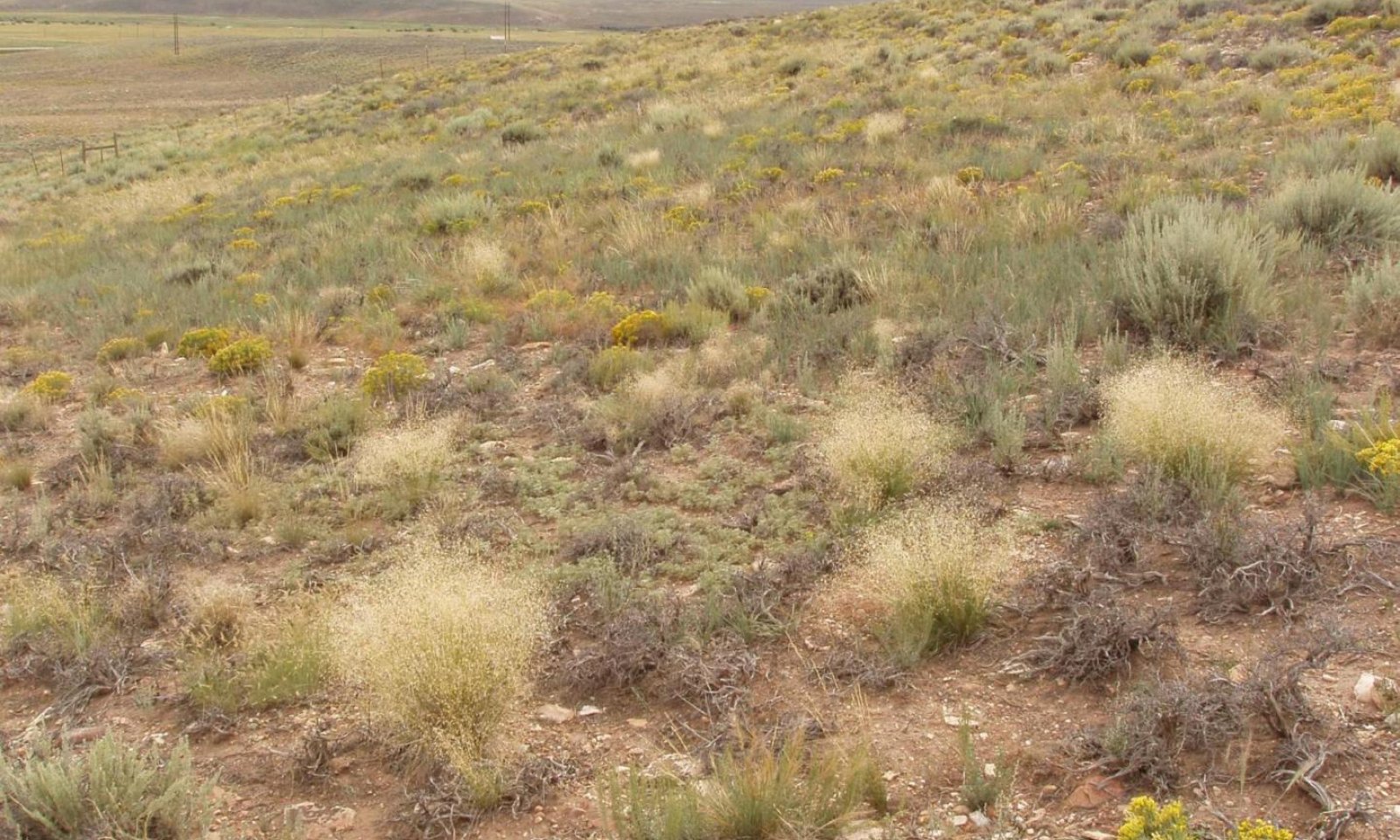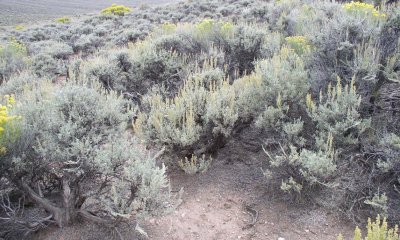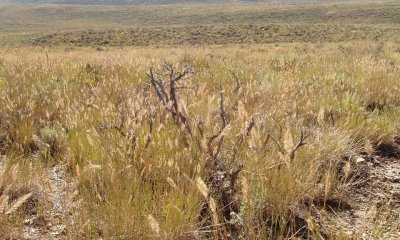
Dry Mountain Loam Gunnison Basin LRU
Scenario model
Current ecosystem state
Select a state
Management practices/drivers
Select a transition or restoration pathway
- Transition T1A More details
- Transition T1B More details
- Restoration pathway R2A More details
- Transition T2A More details
- Restoration pathway R3A More details
- Transition T3A More details
- Restoration pathway R4A More details
-
No transition or restoration pathway between the selected states has been described
Target ecosystem state
Select a state
State 1
Reference



Description
Grass and minor amounts of woody plants such as sagebrush and several forbs make up most of the vegetative cover of this state. The site is treeless; however, trees commonly are in the general vicinity. The dominant grasses are native bluegrasses, Letterman’s needlegrass, pine needlegrass, and Indian ricegrass. Germander beardtongue, spiny phlox, and hollyleaf clover are the principal forbs. Sagebrush may become dominant if the understory species are over-defoliated. The optimum amount of ground cover is 35 percent. The species most likely to increase or invade are cheatgrass, blue grama, and rabbitbrush.
This state represents the community and function of the site prior to European settlement. Two dominant plant community phases are in the reference state. Fire and drought are natural disturbances that drive the pathways between the community phases. The site is subject to frequent periods of drought and fires of mixed intensity and frequency. The fire return interval (FRI) is 10 to 70 years in the more arid sagebrush areas (Wyoming big sagebrush) (Howard, 1999), and it is 15 to 40 years in the wetter mountain big sagebrush areas (Johnson, 2000). Sagebrush species less than 50 years old are easily killed by fire. Most forb species that re-sprout from a caudex, corm, bulb, rhizome, or rootstock recover rapidly following fire, and suffrutescent, low-growing or mat-forming forbs such as pussytoes and buckwheat may be severely damaged by fire (Miller and Eddleman, 2001). Needle and thread (Bunting, 1985), Indian ricegrass, and muttongrass are very palatable and can be over-defoliated. Wyoming big sagebrush, western wheatgrass, yellow rabbitbrush, Sandberg bluegrass (Bunting, 1985), prairie Junegrass (Bunting, 1985), blue grama, and needlegrasses are less palatable and can increase in abundance.
Sagebrush has tap roots, lateral roots and tertiary roots which allows this advantage in competition. Thinning sagebrush crowns may be necessary for understory establishment. Treatments methods need to fit the site’s specific needs. Sagebrush recruitment is episodic in 7-9 year cycles and sagebrush seeds have a limited viability after their second year. (Winward, 2004) Resting and/or deferring grazing after brush management promotes the establishment of grasses which in turn slows down sagebrush establishment. Grazing by species that prefer grasses and forbs will speed up the establishment of sagebrush.
When the density and canopy cover of sagebrush are near maximum for several decades, sagebrush can become competitive with the understory forbs and grasses. Grazing by species that prefer grasses and forbs will speed up the establishment of sagebrush. Sagebrush has tap, lateral, and tertiary roots that give it a competitive advantage. Thinning of sagebrush crowns may be necessary for establishment of the understory. Treatment methods should be adapted to the specific needs of the site. Sagebrush recruitment is episodic in 7- to 9-year cycles, and sagebrush seeds have limited viability after the second year (Winward, 2004). Resting or deferring grazing after brush management promotes the establishment of grasses and slows the establishment of sagebrush.
Submodel
Description
State 2 is a sagebrush-dominant plant community. This state has an increase in shrub cover and a decrease in understory cover as compared to state 1. This sagebrush community is a single-aged stand. The abundance of Sandberg bluegrass and western wheatgrass is increased and that of Indian ricegrass and prairie Junegrass is decreased. The abundance of low shrubs such as yellow rabbitbrush, spineless horsebrush, and broom snakeweed also is increased, replacing some of the herbaceous component in the understory. The diversity of species is lower in this state than in state 1. Improper grazing management practices that decrease the abundance of the deep-rooted understory species can lead to compaction of the soil, increased susceptibility to erosion, decreased organic matter in the soil, and increased exposure of the soil.
Submodel
Description
This state is characterized by sagebrush removal due to fire or shrub management treatments, which may include chaining, disking, and mowing. The community dynamics are similar those of the reference state. This state could persist for long periods. Sagebrush will start to re-establish when the conditions are favorable. This site is seeded to perennial species such as crested wheatgrass and Russian wildrye.
Submodel
Description
State 4 is a sagebrush-dominant community. The abundance of shrub cover is increased and that of the understory is decreased. The sagebrush consists of an even-structured, single-aged stand. The abundance of introduced species is decreased in this community. The abundance of low shrubs such as yellow rabbitbrush and spineless horsebrush also is increased, replacing some of the herbaceous component in the understory. The diversity of species is low. Improper grazing management leads to a decrease in deep-rooted species in the understory.
Submodel
Mechanism
Improper grazing for extended periods during the growing season can reduce the amount of fine fuel in the understory, which favors sagebrush encroachment. Lack of fire over time can cause this transition (McIver et al., 2010). Extended periods of drought and lack of insect and pathogen activity can result in a single-aged stand of sagebrush. This transition is characterized by a decrease in the understory and an increase in the amount of bare ground between the shrubs and other evidence of soil erosion. The depletion of fine fuel due to improper grazing shifts the fire regime from relatively frequent fires of low to mixed severity (10- to 70-year mean fire return interval) to less frequent fires of high severity (more than 70-year mean fire return interval).
Mechanism
Historically, this transition has resulted from a catastrophic wildfire but it can be induced by human activity (shrub management or prescribed burning). It is seeded with introduced species. Short-term loss of topsoil and a reduction in the water-holding capacity in the upper part of the soil occur, and the diversity of species is decreased.
Mechanism
Proper grazing, wet periods, fire after seed set of the understory, and small-scale mortality of shrubs from insects and pathogens can move this community toward a more diverse understory and away from a dense, single-aged stand of sagebrush (Evers et al., 2011). Shrub management, including application of herbicides and prescribed burning, and seeding of native species after burning can be used to mimic this pathway.
Relevant conservation practices
| Practice | External resources |
|---|---|
|
Brush Management |
|
|
Prescribed Burning |
|
|
Range Planting |
|
|
Prescribed Grazing |
Mechanism
This transition is human induced through shrub management, prescribed burning, and reseeding with introduced species after a catastrophic wildfire.
Mechanism
The site may be restored to resemble the Indian ricegrass and Wyoming big sagebrush community in the reference state by seeding commercial mixtures of native grasses, forbs, and shrubs. Selective removal of introduced species also may be needed. If properly managed, a semblance of the diversity and complexity of the reference state can be restored. This restoration pathway is intensive if attempted on a large scale.
Mechanism
Improper grazing for an extended period and lack of fire are the main drivers of this transition. Extended periods of drought also can affect the productivity of the understory. These factors can return the community to a mature, single-aged shrub community that has a few seeded introduced species in the understory, mostly under the canopy of the shrubs.
Mechanism
Fire and wet periods can cause the mature, single-aged shrub community to return to a grassland state if proper grazing management is implemented and sufficient seed is in the seed bank to regenerate the understory species. If sufficient seed or mature plants are not available for this pathway, reseeding may be needed. Shrub management practices such as prescribed burning, prescribed grazing, and seeding could help to move the community from state 4 to state 3.
Relevant conservation practices
| Practice | External resources |
|---|---|
|
Brush Management |
|
|
Prescribed Burning |
|
|
Fence |
|
|
Range Planting |
|
|
Watering Facility |
|
|
Upland Wildlife Habitat Management |
|
|
Prescribed Grazing |
Model keys
Briefcase
Add ecological sites and Major Land Resource Areas to your briefcase by clicking on the briefcase (![]() ) icon wherever it occurs. Drag and drop items to reorder. Cookies are used to store briefcase items between browsing sessions. Because of this, the number of items that can be added to your briefcase is limited, and briefcase items added on one device and browser cannot be accessed from another device or browser. Users who do not wish to place cookies on their devices should not use the briefcase tool. Briefcase cookies serve no other purpose than described here and are deleted whenever browsing history is cleared.
) icon wherever it occurs. Drag and drop items to reorder. Cookies are used to store briefcase items between browsing sessions. Because of this, the number of items that can be added to your briefcase is limited, and briefcase items added on one device and browser cannot be accessed from another device or browser. Users who do not wish to place cookies on their devices should not use the briefcase tool. Briefcase cookies serve no other purpose than described here and are deleted whenever browsing history is cleared.
Ecological sites
Major Land Resource Areas
The Ecosystem Dynamics Interpretive Tool is an information system framework developed by the USDA-ARS Jornada Experimental Range, USDA Natural Resources Conservation Service, and New Mexico State University.




